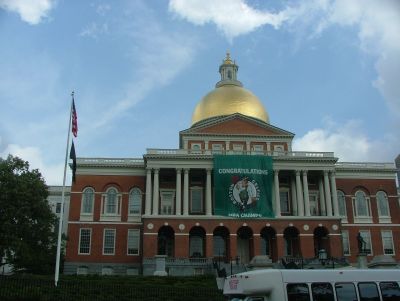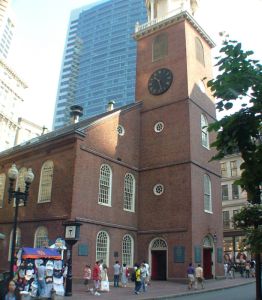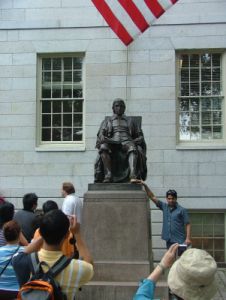Two days in Boston, Massachusetts
 After
our visit to Mystic Seaport we continued northeast
through Connecticut and into Rhode Island, America's
smallest state and before
we noticed, we were in Massachusetts.
Here we stayed on the Interstate all the way to
Boston.
After
our visit to Mystic Seaport we continued northeast
through Connecticut and into Rhode Island, America's
smallest state and before
we noticed, we were in Massachusetts.
Here we stayed on the Interstate all the way to
Boston.
We found our pre-booked hotel without any major
problems.
The hotel, Hyatt Regency, was located in Cambridge,
north of the Charles River, and approx. 8
miles
from downtown Boston.
After settling in the room, we
took a taxi to the Boston Common for 13 dollars,
which we thought was cheap compared with taxi prices
in Denmark.
It proved, moreover, later it was still cheaper to
ride home from town, because Boston taxis had lower
rate than Cambridge taxis, so we could get home for
about
$ 9.
Boston Common is a public park and it's located
right in the center of Boston. From
here "The Freedom Trail" leads it's way around
Boston. Following the trail
is a stroll through history or at least the historic
Boston. The trail leads past a number of historic
buildings, cemeteries, etc..
The route is marked in the pavement with two rows of
red bricks (sometimes replaced by a painted red
stripe) so it's easy to follow.
In one corner of Boston Common is an information
center, and here we bought a leaflet that told of
the Freedom Trail.
We started the tour by going uphill from the
information center to Beacon Hill and the "new"
State House from 1795, and then we just followed the
trail from there.
Most exciting was in my opinion, Granary Burying
Ground.
It is an old cemetery, which has been in use since
the 1660's
Here, among others Benjamin Franklin's parents and
his siblings are buried.
Moreover, James Otis, John Hancock, Samuel Adams,
Peter Faneuil, Paul Revere are buried here.
All men who had great significance before, during
and after
the American Revolutionary War.
From the cemetery we went to another cemetery,
King's Chapel Burying Ground.
It is Boston's oldest graveyard, serving as a
burying ground since
1630. The
family burial place of John Winthrop, first governor
of "Massachusetts Bay Colony" is found here.
Among other interesting places we passed was the Old
South Meeting Hall. Originally a church the building
today serves as
a museum.
The Old South Meeting Hall was for many years the
largest building in town, and it was here about
7,000
colonists, a few disguised as Mohawk indians gathered before the
"Boston Tea Party."
In a house next to this building Benjamin Franklin
was born in 1706, but the house has long since
burned down, so today the place is marked with a
plaque.
 Next
stop was the "Old State House" from 1713, and thus
the oldest public building in Boston.
Here James Otis made a famous speech against
colonial rule in 1761, and from the balcony of this
building the American Declaration of Independence
was read to the population for the first time on the
18th of
July 1776.
The building is called "The house where independence
was born".
Also the Old State House is now a museum.
Just below the balcony the Boston Massacre took
place in 1770 when British soldiers - strongly
provoked and threatened by a crowd - shot into the
crowd and killed five Bostonians.
The exact place is now marked with a circle of
cobblestones.
Next
stop was the "Old State House" from 1713, and thus
the oldest public building in Boston.
Here James Otis made a famous speech against
colonial rule in 1761, and from the balcony of this
building the American Declaration of Independence
was read to the population for the first time on the
18th of
July 1776.
The building is called "The house where independence
was born".
Also the Old State House is now a museum.
Just below the balcony the Boston Massacre took
place in 1770 when British soldiers - strongly
provoked and threatened by a crowd - shot into the
crowd and killed five Bostonians.
The exact place is now marked with a circle of
cobblestones.
We continued past Faneuil Hall, with it's
marketplace (Quincy Market), and further on to the
northern part of Boston, The North End, which today
is a typical Italian neighborhood with lots of
Italian restaurants.
Here we looked at Paul Revere's house, or rather the
house he lived in. The house is much older, from
1680 (and thus Boston's oldest building).
Paul Revere bought the house in 1770 and moved in along with his
wife and the five children he had at the time.
Later, he had an additional 11 children - a prolific
gentleman of his time (I wonder how he found time to
be a revolutionary.).
Not far from the house is the Old North Church where
Paul Revere, as one of his many jobs was bell
ringer.
It was here that he had two lantern hoisted in the
tower before
his famous ride to Lexington.
From
the North End we crossed Charlestown Bridge to see
the USS Constitution and Bunker Hill, the two points
on the Freedom Trail, which are on the other side of
river.
When we crossed the bridge however, we were overtaken
by a thundershower, so we had to hurry across the
bridge to find shelter.
When the shower had passed, and we could go on, we
agreed that we would rather go back to North End and
find a place to eat.
We chose to eat at The Green Dragon Tavern, which
some historians have called "Headquarters of the
Revolution".
Here they the conspirators from Sons of Liberty, the
North End Caucus (with among others John Hancock and
Samuel Adams among its members) and the Boston
Committee of Correspondence met and made the plans,
which later led to the American Revolution.
Paul Revere later wrote in his diary: "About 30
people, mostly artisans from North End, had agreed
to observe the British soldiers and loyalist
movements so that they could predict when they would
strike at the Concord.
These patriots met at the Green Dragon Tavern."
It was after such a meeting at the inn, that Dr. Warren
sent Revere on his famous ride to Lexington. In 1788
it was also at this inn that influential inhabitants
of the state met and agreed that
Massachusetts would ratify the U.S. Constitution.
The original building has been torn down along the
way so the premises are not from revolutionary
times, but it was exciting anyway. From the
restaurant we walked around the city a little while,
and then took a taxi back to hotel.
The next day we once again took a taxi to Boston Common or
rather the next door park, Public Gardens. The
consierge at
our hotel, had told us that this park Public
Gardens, was much prettier than The Commor, so
before the bus trip we went for a walk in the park,
and it was actually very nice, with a small
lake where you could have a tour on a small boat.
After visiting here, we went to the
information office in Boston Common and bought a
ticket for one of the four different bus tours
around Boston.
We walked up the hill to New State House and caught
a bus there.
The trip was excellent and even if it was a hop
on-hop off bus, we just stayed on board for the
duration of the trip.
We saw some of the places we had seen the day before,
but also some new stuff, including Business District,
a part of the port, including the location of the
Boston Tea Party in 1773.
We also crossed the river to Charles Town and saw
the USS Constitution or "Old Ironsides", the ship we
had missed the day before.
 Along the way we drove past two of Boston's many
famous educational institutions, Boston University,
south of the river, and the Massachusetts Institute
of Technology (MIT), north of the river.
The latter is probably the best known, most
prestigious and perhaps best technical education
center in the world.
No less than 15 Nobel laureates have graduated from
MIT.
Moreover, MIT presently
employs eight Nobel Prize winners.
Along the way we drove past two of Boston's many
famous educational institutions, Boston University,
south of the river, and the Massachusetts Institute
of Technology (MIT), north of the river.
The latter is probably the best known, most
prestigious and perhaps best technical education
center in the world.
No less than 15 Nobel laureates have graduated from
MIT.
Moreover, MIT presently
employs eight Nobel Prize winners.
When
the bus tour was over, we went shopping for a few
items, like a charger for our GPS receiver and we
took a closer look at Granary Burying Grounds than
time had allowed us the previous day. Then we
walked to Faneuil Market, where we had some lunch.
Before we left home, our excellent dentist through
many years, Johanne, had told Dorte that when we
came to Boston she had to visit Filene's Basement.
It would be just her thing.
Since I am a little afraid of dentists, and have
great respect for Johanna after 25 years of
acquaintance, we had to obey, and of course find
this place.
Unfortunately it proved to be closed!
The whole house was closed and was either under
demolition or possibly rebuilding, it was not
entirely clear, but at least one half of the
building was lacking.
We therefore had to resign, and in stead we walked
back to Boston Common.
Here we found a taxi and we drove to Harvard Square
in Cambridge.
Here we visited America's oldest university, founded
in 1636 when a group of citizens granted £ 400 to
build a theological university.
£ 200 immediately and 200 pounds, when work was
completed!
Later John Harvard granted more money for the
venture, and in 1638 the university was renamed to
Harvard University and that same year, the place
where it was built was renamed from Newetowne to
Cambridge.
We walked around and looked at the buildings for a
while.
Although it was summer, there were plenty of people,
both students and tourists.
After the visit to Harvard, we walked a few miles
out to the former Radcliffe College. This used to be an all-female college, in the days when Harvard was just
for men.
Women were first admitted to Harvard in 1975 and in
1977 Radcliffe officially merged with Harvard.
Not until 1999 however, it was completely closed as
an independent College.
Today, Radcliffe is used as a research center within Harvard,
and some of the buildings are used as accommodation for
students.
At Radcliffe we were virtually alone, so here
tourists apparently do not bother to come, and it is
quite a walk out there.
Among other twe passed on the way out there was the
oldest wooden church building in Cambridge,
Christchurch from the 1760. When
we had seen enough, we went back to one of the major
streets, where we
managed to find a taxi and we went back to the hotel
to rest our tired legs and aching feet. That evening
we had dinner at the hotel :-)
- Return to New
Enlgand and New York -
- Return to Travel Stories -